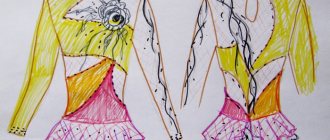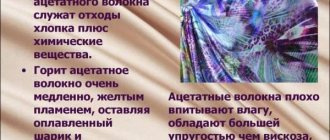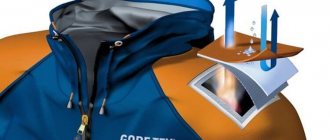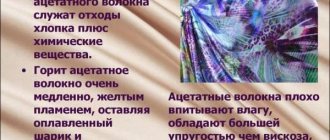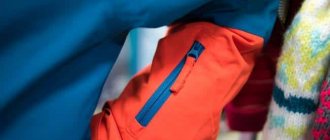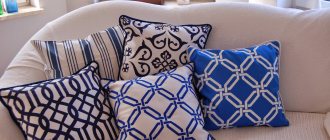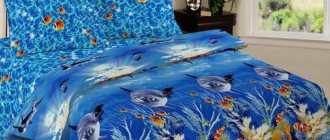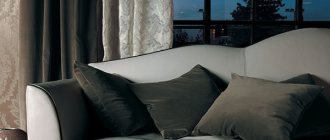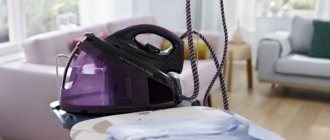You need to choose clothes for sports carefully. It must be hygienic, but at the same time durable. The best fabric for sportswear is knitwear with the addition of cotton or viscose. In second place is diving.
Of course, when choosing, it is important to take into account the type of sport. For yoga, running, and acrobatics, uniforms are made from the most elastic, wear-resistant materials. Climbers and skiers need uniforms that keep them warm. Tracksuits for everyday wear can be made from footer, velor and other soft and comfortable fabrics.
How to choose fabric for sportswear - 7 main qualities
Sportswear must meet certain requirements:
- Elasticity. Almost any type of training requires active movement. Therefore, things must have sufficient stretchability.
- Breathability. During sports, the skin needs to breathe. Otherwise, the body will overheat and sweat. This can have the most negative consequences: suffocation, palpitations, diaper rash and others.
- Hygroscopicity. Under heavy loads, a person sweats. Sports fabrics must absorb liquid to make exercise comfortable.
- Thermal insulation. If training is carried out outdoors or in water, it is important to protect the body from hypothermia.
- Wear resistance. Heavy loads can quickly render sportswear unusable. The most important criteria when choosing fabrics for training is resistance to tearing, abrasion, and repeated washing.
- Easy to care for. Sports uniforms are washed frequently. Therefore, it is important that clothes dry quickly and do not wrinkle.
- Aesthetic appearance. A criterion on which the self-esteem and motivation necessary to achieve heights in sports may depend.
Properties
In addition to high tensile strength, it has many more advantages:
- stains are washed quickly; in most cases, to remove a dirty stain you only need to soak the item in clean water;
- thin, therefore suitable for sewing swimsuits and bodysuits;
- has high levels of breathability, especially when it comes to a mixed material in which, in addition to elastic fibers, natural threads are added;
- durable, things made from it will last for several years without losing their original appearance, and no traces of dirt remain on them;
- not prone to the appearance of pellets;
- does not fade;
- retains color;
- things don't wrinkle.
Elastic is a fabric that does not deform even when exposed to salts. Things retain their color after many washes. The fabric is soft, but at the same time dense, pleasant to the touch, does not cause irritation, and absorbs sweat. Despite the fact that the material accumulates static electricity, experiments have shown that it is distributed evenly over the entire area, that is, it does not cause inconvenience.
Types and composition of sports fabrics
Most often, fabrics for sportswear are mixed. Natural ingredients make the material hygienic. They allow oxygen to pass through well and absorb moisture. Synthetic fibers have such advantages as wear resistance, elasticity, and attractive appearance. In different proportions in the composition of sportswear you can observe:
- Natural ingredients: cotton, viscose, less often silk, wool.
- Synthetic: elastane, spandex, nylon, polyester, polyamide and others.
Sports fabrics can be divided into three types:
- Elastic fabrics for leggings, cycling shorts, sports tops. They are made from materials that stretch well, but at the same time keep their shape and do not deform. Mostly it is synthetic: polyester, elastane, spandex, supplex. Sometimes a small percentage of natural raw materials is added to them.
- Fabrics for outer sportswear. Mainly it is a membrane. Jackets and suits made from it do not get wet, retain heat well, but at the same time allow body evaporation to pass through. They are always comfortable. The body does not sweat and does not freeze. Additional materials used include polyester, fleece, elastane, wool, and Thinsulate (insulation, thermal underwear, lining).
- Fabrics for casual sports suits. Clothing for walking does not require serious physical activity, so the requirements for materials are reduced. Suits are usually made from sports two-thread, three-thread, footer, velor, neoprene, raincoat fabric and fleece.
Footer: comfort with fleece
Footer is natural cotton fabric. Due to its inherent properties, it is even used for children's clothing. The front surface is smooth and dense, slightly silky, the back has a short, pleasant backcomb.
Footer is a “blend” of cotton with synthetic fibers
The footer is woven from 2 types of threads: smooth, strong at the base and soft, loose, slightly twisted. Sometimes synthetics are added to improve elasticity: lycra, elastane.
Important! The footer is not woven, but knitted with broaches: loops of threads are firmly held together, but retain elasticity.
Top 3 best sports fabrics
A wide variety of fabrics are used to make sportswear. Among them there are both universal and specially designed for training. Let's look at the Top 3 best sports fabrics that are in great demand:
- Diving. Very elastic and wear-resistant material. It is called the “second skin”. Diving was specially designed for sports - athletics, gymnastics, swimming and other sports. It has all the necessary criteria. When containing viscose, it allows air to pass through and absorbs moisture. Low quality diving lacks this ability.
- Dazel. Also developed for sportswear. It is a knitted fabric made of synthetic (polyester) threads. This is a very durable, wear-resistant material. Dazel has excellent oxygen and moisture permeability.
- Two-thread and three-thread (footer). This is knitwear, the front side of which is smooth, and the back side consists of loops. A special feature of the material is its natural or semi-natural composition with a predominance of cotton. The reverse side often has a small comb that retains heat and absorbs moisture. The footer is breathable, but does not stretch very well and has average wear resistance.
Diving – elastic beauty
Fabric for leggings - what is it called? Its other names are “sports jersey” or “second skin”. Diving is a knitted blend of viscose, polyester and lycra, a sports jersey-fabric. Artificial viscose “occupies” 50-70% of the total composition, lycra and polyester add increased strength and elasticity to the material.
Diving is not only a sport, but also the name of a fabric
Fabric is divided into 2 types:
- Microdiving: thin, light and extremely flexible. Used for sewing swimsuits, clothing for athletes and gymnasts.
- Crepe diving: denser and stronger, characterized by highly twisted fibers. They sew women's and men's suits for cyclists, automobile and parachute sports.
Questions and answers
Question: What fabric is ideal for a tracksuit?
Answer: For everyday wear and home workouts, knitwear with a high cotton content is best. Such clothes are not very durable, but they are hygienic, comfortable and affordable. For regular workouts in the gym, you should take a closer look at leggings and tops made of diving or other fabric with a predominance of polyester.
Question: Can sportswear be made from pure cotton or other natural materials?
Answer: Yes. The lack of elasticity can be compensated for by a special cut. For example, kimonos and obi are made from natural fabrics. It is also possible to play sports in the classic model of cotton Afghani pants.
When choosing which fabric to purchase or sew sportswear from, you should consider the type of activity. Some materials are suitable for training in the gym, but completely different ones for CrossFit on the street. Sports direction is of fundamental importance. After this, the material is tested. Then the new sports kit will certainly please you and bring only positive emotions and victories!
How to sew leggings with your own hands?
To create a leggings pattern you will need five measurements.
- Hip volume.
- Waist.
- Inseam length.
- Length along the outer seam from the waist.
- The circumference of the ankle or the place where the product will end.
And now the construction of the pattern.
- Set aside the total length.
- From the bottom point, set aside ½ of the circumference of the ankle.
- Draw a segment upward equal to the step length.
- Draw a perpendicular through the resulting point to the step segment.
- From the outer line to the left along the perpendicular, set aside ¼ About and put a point.
- Connect the point on the ankle line with the point on the hip line.
- Set aside ¼ from the long vertical to the left.
- With a dotted line, lower the perpendicular down until it intersects with the hip line.
- Use a smooth line to draw out the groin area.
¼ of the leggings drawing is ready. The graph paper showed a scaled drawing.
Fashion trends
If we talk about trends, the following are popular now:
- space, pixel and abstract patterns;
- animal and floral prints;
- transparent inserts;
- practical synthetic materials.
The Pantone Institute has unveiled its colors of 2021: Ultimate Gray and Illuminating Yellow.
Landing
High-waisted leggings visually elongate the proportions of the body: they lengthen the legs and focus attention on a thin waist. Due to the tight, wide waistband, these leggings fit perfectly and do not slip down during active training. They are comfortable for squatting, bending and twisting, and working with a barbell or your own weight. Thanks to the high waist and ergonomic cut, the leggings will not create discomfort while moving.
Low-rise models look great on slender and fit girls. But you should understand that it is not always convenient to train in such leggings.
